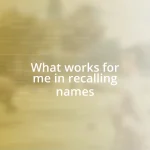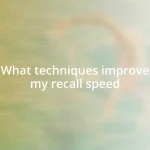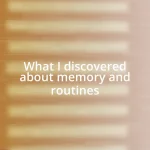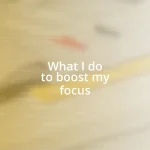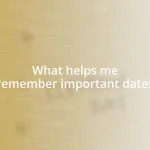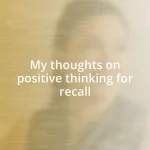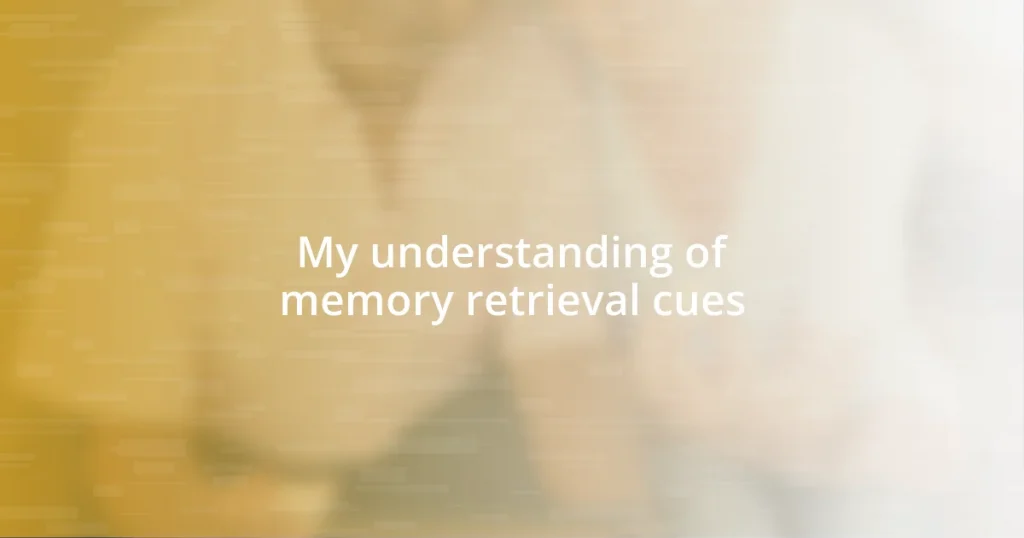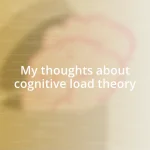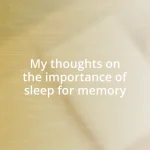Key takeaways:
- Retrieval cues, such as visual, contextual, and emotional stimuli, are essential for accessing memories, enhancing recall, and connecting us to our past experiences.
- Creating strong associations through mental imagery, emotional connections, and familiar environments can significantly improve memory retrieval and retention.
- Practical applications of retrieval cues are present in daily life, such as using reminders in planners, storytelling, and communal experiences in professional settings, which foster stronger connections and enrich interactions.
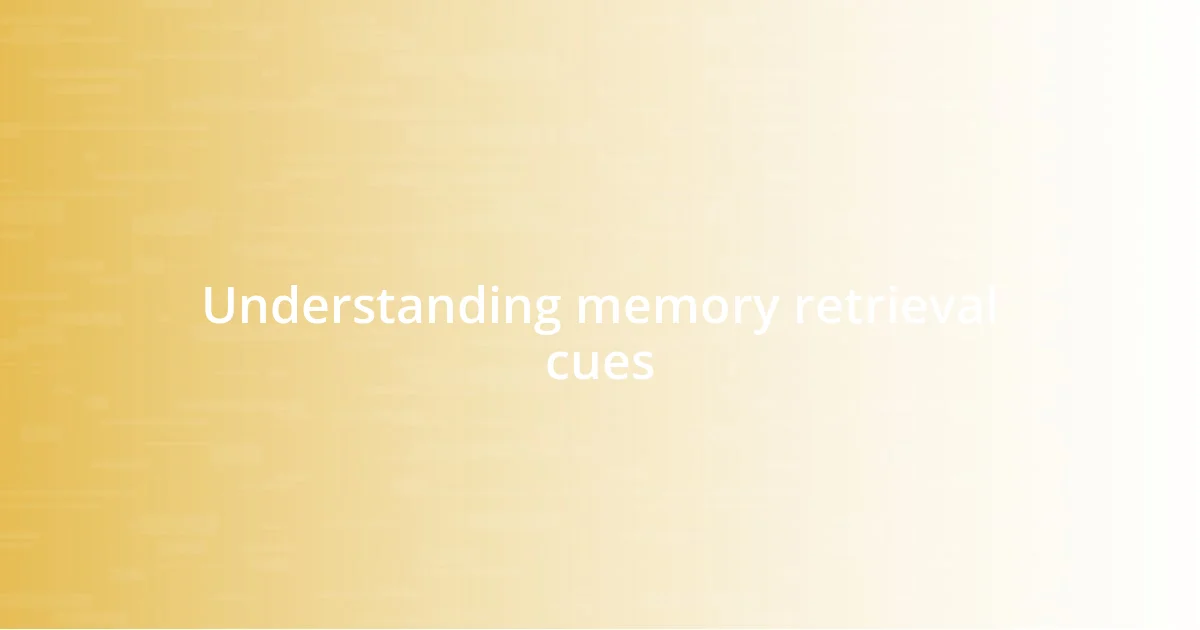
Understanding memory retrieval cues
Retrieval cues play a vital role in how we access memories tucked away in our minds. Think back to a time when a specific smell sparked a flood of childhood memories—perhaps the aroma of freshly baked cookies reminded you of your grandmother’s kitchen. Isn’t it fascinating how a simple cue can unlock so much?
I often reflect on how certain songs trigger vivid images and emotions from my past. It’s almost as if soundwaves can connect us to moments that we might have otherwise forgotten. How do you think your favorite melodies serve as a retrieval cue for your own experiences?
Consider the context in which you first learned something. That moment in class, surrounded by peers, can become a powerful retrieval cue. I’ve noticed that studying in the same environment where I learned the material helps me recall information more effectively during tests. What environments have helped you remember important details?

Importance of retrieval cues
Retrieval cues are essential because they act like signposts in the complex landscape of our memories. I remember a time when I stumbled upon an old photograph—suddenly, a vivid recollection of a family vacation rushed back. That single image served as an incredibly effective cue, proving that our memories are often intertwined with sensory experiences.
When considering retrieval cues, it’s fascinating how they can enhance recall in educational settings. I personally find that using mnemonic devices—like visual imagery or acronyms—helps me retain information far better. This technique not only makes studying more enjoyable but also showcases how structured cues can guide our brains to access stored knowledge more efficiently.
Moreover, the emotional connection we have with certain retrieval cues cannot be understated. For example, the sound of rain hitting the window evokes memories of cozy nights spent reading. Each droplet feels like a nudge back in time, emphasizing just how powerful these cues can be in enriching our lives and experiences.
| Type of Retrieval Cue | Importance |
|---|---|
| Visual Cues | Evokes strong imagery and emotions, triggering specific memories. |
| Contextual Cues | Enhances recall by linking memories to the environment where they were formed. |
| Emotional Cues | Strengthens connections to memories, making them more vivid and accessible. |
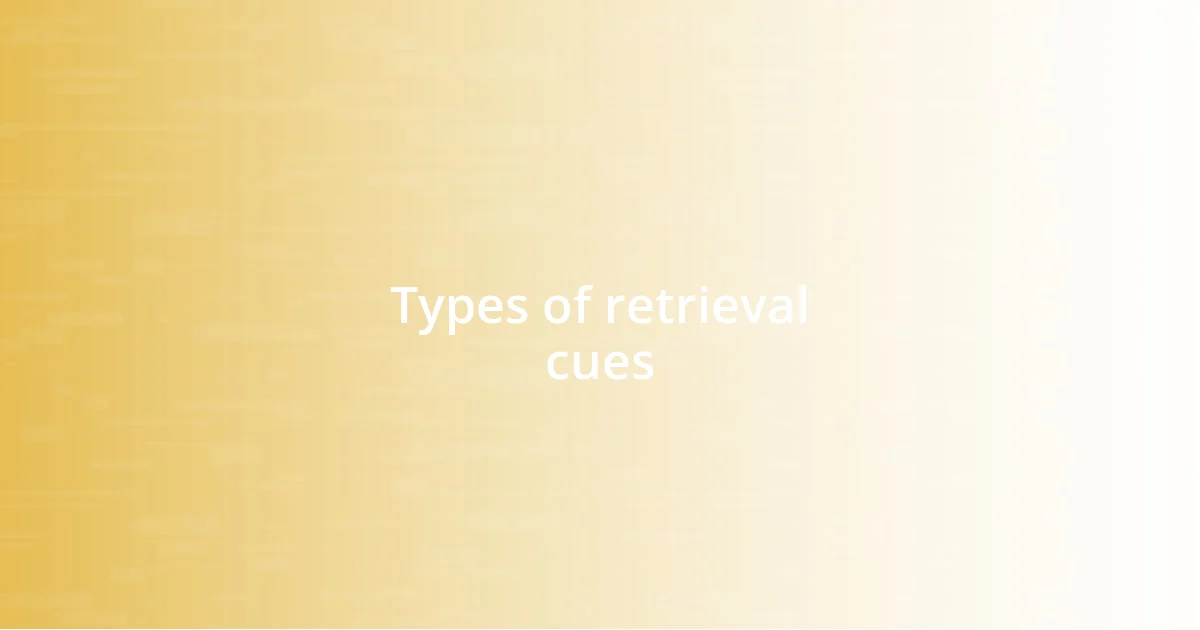
Types of retrieval cues
When I think about the types of retrieval cues, several stand out in my experience. Visual cues, like photographs or certain colors, often transport me back to specific moments. I recall looking at an old map of my hometown and instantly remembering the thrill of riding my bike down familiar streets, sparking nostalgia and warmth. Similarly, contextual cues can be incredibly effective. For instance, studying in the same café where I initially grasped a subject often helps me recall details more clearly during exams.
- Visual Cues: They evoke strong imagery and nostalgia, prompting specific memories tied to sights.
- Contextual Cues: These cues enhance recall by anchoring memories to the environment or situation where they were formed.
- Emotional Cues: They draw on our feelings to strengthen memory connections, making recollections more vivid and relatable.
Each cue offers a unique way to access our memories, illustrating how interconnected our experiences truly are. It’s intriguing to notice how tapping into these different types can lead us not only to knowledge but also to cherished moments that shape who we are.
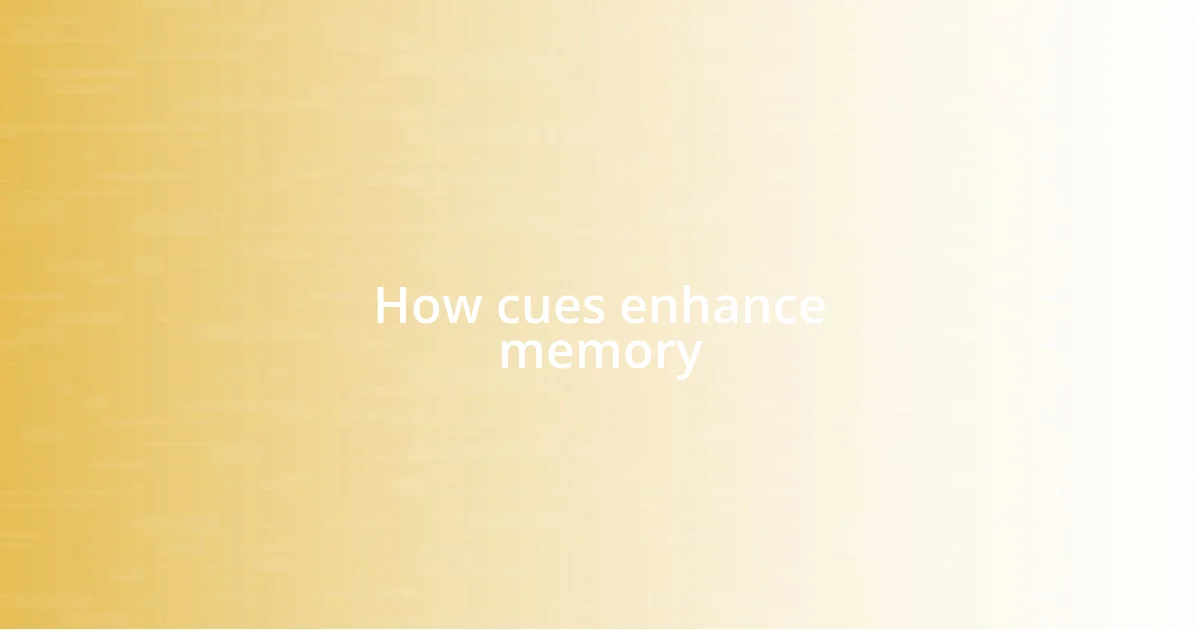
How cues enhance memory
When I think about how cues enhance memory, it’s clear they serve as gateways to our past experiences. For instance, the smell of fresh cookies baking takes me back to my grandmother’s kitchen, where I spent countless afternoons. Isn’t it fascinating how a simple scent can unlock such vivid memories? It’s almost like our minds are hardwired to connect specific cues to emotions and moments in time.
Interestingly, the context in which we learn plays a huge role in memory retrieval. I remember studying for my exams in my childhood bedroom, surrounded by familiar sights and sounds. When I took the tests, just being back in that environment helped me recall facts and concepts much more effectively. Have you ever noticed how being in a particular place can trigger knowledge you thought was long gone?
Emotional cues also enhance memory retrieval in remarkable ways. I often find that music brings back memories I didn’t even realize were tucked away in my mind. A song from high school instantly transports me to moments of laughter and carefree days. Those emotional connections make our memories more accessible and vivid, reinforcing the idea that feelings and recollections are intricately linked.

Techniques to use retrieval cues
Using retrieval cues effectively can transform how we access our memories. One technique I often utilize is creating a rich mental image associated with the information I want to recall. For example, when trying to remember a friend’s birthday, I might visualize a vibrant cake adorned with specific colors that reflect their personality. This visual anchor not only makes the information stick but also brings a smile to my face every time I think about it.
Another method I find particularly helpful is linking new information to an emotional experience. I once tied a challenging history lesson to a family road trip where we visited significant landmarks. The combination of the lesson and the excitement we felt on that trip transformed my understanding. It’s interesting to consider: how many times have you learned better because you associated it with an enjoyable experience? That emotional tie can create a powerful retrieval cue.
Moreover, I often revisit contexts where I originally learned about specific topics. I remember preparing for a presentation while walking through a local park where I brainstormed ideas for a class project years ago. Being in that environment sparked memories and insights that I thought were lost. Have you experienced something similar? Being in a familiar place can reignite forgotten knowledge, proving how powerful contextual cues can be in our memory retrieval journey.
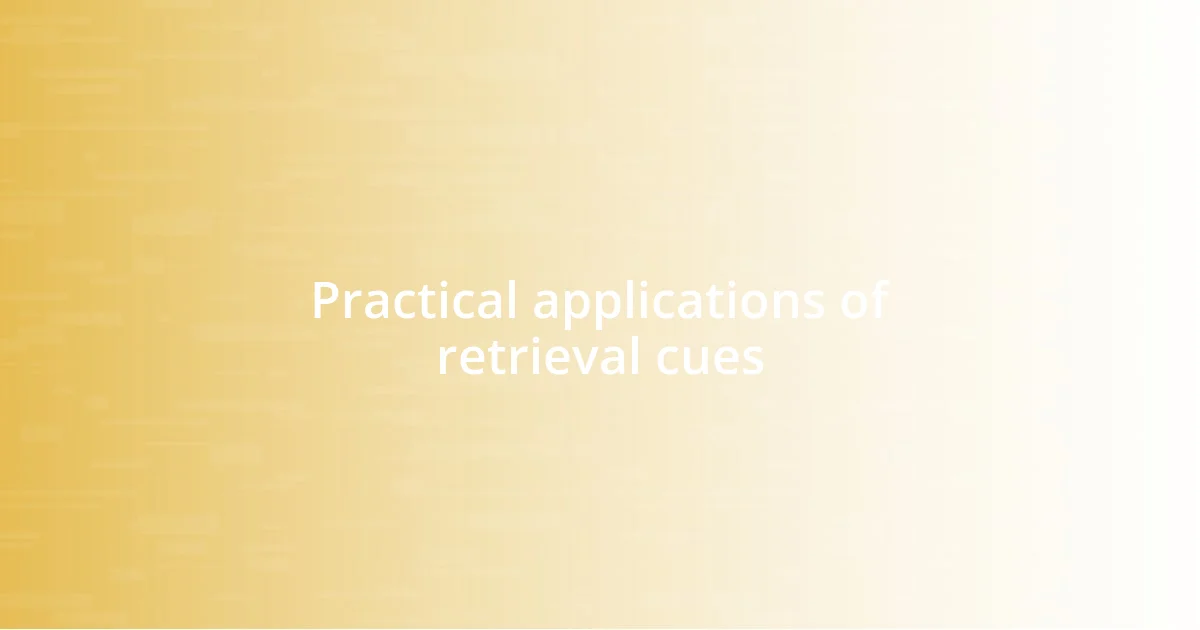
Practical applications of retrieval cues
In my experience, retrieval cues find a meaningful application in the way we organize our daily lives. For instance, I often use specific notes in my planner associated with particular tasks. When I glance at a reminder that says “guitar practice,” it not only prompts me to pick up my instrument but also revives memories of the joy I felt when I first learned to play. Have you ever thought about how certain words or symbols can effectively guide you through your day?
I also notice that retrieval cues play a vital role in social connections. When I hear a specific phrase my best friend always used to say, it sparks cherished memories of our high school adventures. The laughter and support we shared come flooding back. It’s incredible how something as simple as a word or phrase can create a bridge to those warm feelings. Have you experienced a moment where a familiar saying took you down memory lane, reminding you of a special person?
An interesting application I’ve discovered is how retrieval cues can enhance learning in professional environments. During team meetings, I find it helpful to refer back to shared experiences or previous discussions. For instance, mentioning a funny story from a past project can lighten the atmosphere and make everyone feel more connected. It’s those shared references that can turn a mundane meeting into a lively exchange of ideas. How often do you draw upon group experiences to breathe life into your professional interactions?
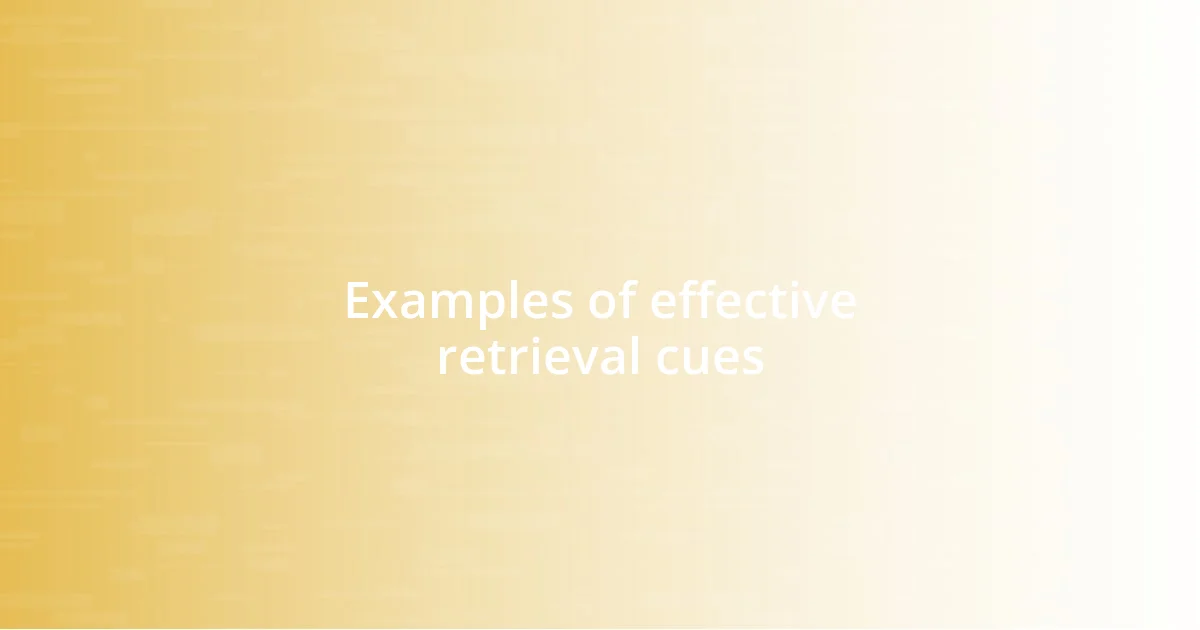
Examples of effective retrieval cues
When I think about the power of music as a retrieval cue, I can’t help but recall the time I heard a song that reminded me of my high school prom. That catchy tune instantly took me back to the excitement of that night—the shimmering lights and my friends dancing joyfully. It’s fascinating how a melody can transport us to a moment, reminding us not just of the event but of the emotions we felt. Have you ever noticed how a song can evoke a specific memory with just a few notes?
Another effective retrieval cue I often utilize is the art of storytelling. I remember during a family gathering, my uncle regaled us with stories from his childhood about our grandparents. As he talked, I could vividly picture my grandparents as young adults, engaged in their adventures. This connection between the narrative and my family’s history sparked memories I hadn’t thought of in years. Isn’t it amazing how a well-told story can weave together details that help us remember our roots and the people we love?
I’ve also found that particular scents can serve as potent retrieval cues. One day, while baking cookies with a friend, the smell of chocolate chip cookies wafted through the kitchen, instantly reminding me of my grandmother’s warm hugs and her classic cookie recipe. That simple scent brought back a flood of images and sensations, from the sound of her laughter to the warmth of her kitchen. It makes me wonder: how often do we overlook scents that could bring cherished memories back to life?
